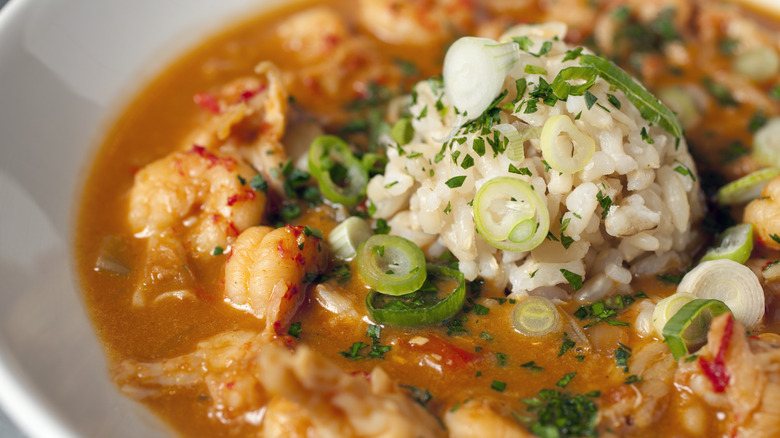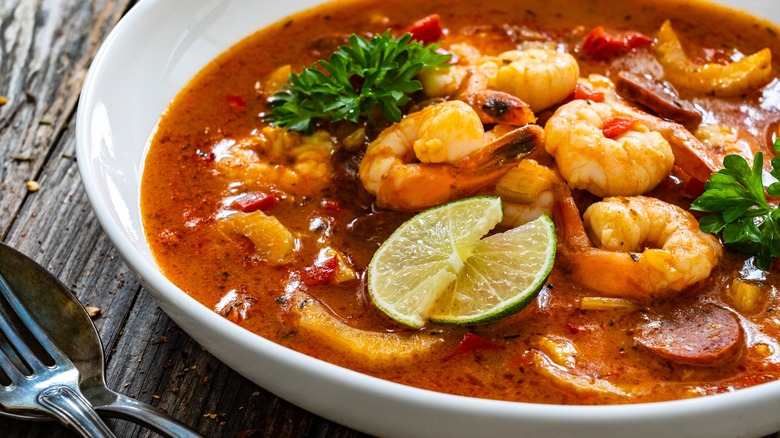The Textural Difference Between Étouffée And Gumbo
Étouffée and gumbo stand out as two of the most popular dishes from New Orleans' rich culinary heritage. Although both meals hail from the Big Easy, they each have their own unique textural qualities and cooking techniques that make them different.
Étouffée, meaning "smothered" in French, consists of a thick, slow-cooked gravy typically made with seafood served over rice. Tomatoes add a slight sweetness to the dish while local shellfish, like shrimp or crawfish, add a briny flavor that counters the spicy Cajun seasonings. It's all garnished with some extra zing from chopped green onions.
Gumbo traditionally combines a mix of Andouille sausage, chicken, seafood, and vegetables simmered together in a hearty stew. Its stock of smoked meats and aromatics is spiced with seasonings, like thyme, bay leaves, garlic, and jalapeño. Unlike étouffée, gumbo comes with rice on the side.
Étouffée and gumbo have a lot in common in their origins in Cajun and Creole cooking. However, they vary in texture and taste. So, how do they turn out so differently? The secret's in the sauce. Étouffée uses much less liquid stock than gumbo. That gives étouffée a thicker consistency, one that slowly smothers over rice. Compare that to gumbo's more soup-like texture, which is thanks to its higher liquid content of water or broth.
It all begins with the starter roux for étouffée and gumbo
Like most meals made in New Orleans, it all starts with the roux. It's the secret to those rich, creamy sauces that characterize the regional cooking and appear in countless sauces, soups, and stews. Roux comes down to a 1:1 ratio of flour and fat. Many recipes, like macaroni and cheese, call for butter or milk as the fat. But, down south, they go bold, often using lard instead. In general, all-purpose flour is used.
The trick to both of these NOLA favorites is to never stop stirring. Roux requires continuous mixing so it doesn't burn or clump (so you'll have to work that forearm!). The longer the whisk, the darker the roux will become and causes the flavors to develop differently. This is truly where gumbo and étouffée start to diverge. A quicker roux, like one used in étouffée, taste a bit like lightly-toasted bread. When it's stirred longer, such as for gumbo, the roux not only appears darker but tastes bolder and richer.
Étouffée uses a lighter-colored blonde roux, which takes up to 15 minutes to achieve its perfect peanut butter hue. But, if you keep blending for at least 25 minutes, you'll achieve the dark brown roux needed for gumbo. An electric mixer can help get the job done, although it may diminish respect from the Big Easy old timers.
The perfect drink pairings for your New Orleans meal
Étouffée and gumbo might have different textures, but they both wash down well with a Southern-style classic cocktail. After all, what's a New Orleans meal without a lively libation to capture the spirit of the city?
Class it up for happy hour with a French 75 inspired by Arnaud's French 75 Bar in New Orleans' French Quarter. This cocktail couples cognac and champagne with a hint of lemon juice and sugar, offering a sophisticated sip before your meal.
For something with a kick, the Sazerac combines rye whiskey, bitters, and a sugar cube garnished with a lemon peel. To do it right, use Peychaud's bitters (a New Orleans original created by Antoine Amédée Peychaud in the mid-1800s). The bitterness in this drink will beautifully balance the mild sweetness of the étouffée.
Cajun gumbo, on the other hand, doesn't taste as sweet as an étouffée (since gumbo is made sans tomatoes) though Andoille sausage and hot peppers turn up the heat. That makes a fruity drink perfect to tamper the powerful seasonings. Go for a hurricane, which blends light and dark rum with lime juice, orange juice, simple syrup, grenadine, and ice, served in a tall glass. The popular beverage originates from Pat O'Brien's, a Bourbon Street establishment that started out as a speakeasy during the Prohibition era.



